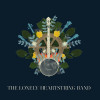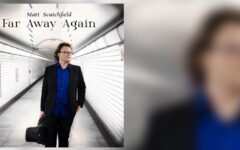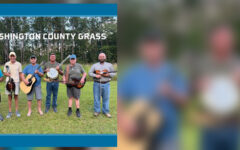
 Deep Waters, the debut Rounder project for The Lonely Heartstring Band, may well be a precursor of what bluegrass music will sound like in the future. In a way I’ve yet to see accomplished as successfully before, they manage to incorporate a more complex harmonic structure such as is common in popular and theatrical music, with the rhythmic intensity and drive long associated with bluegrass.
Deep Waters, the debut Rounder project for The Lonely Heartstring Band, may well be a precursor of what bluegrass music will sound like in the future. In a way I’ve yet to see accomplished as successfully before, they manage to incorporate a more complex harmonic structure such as is common in popular and theatrical music, with the rhythmic intensity and drive long associated with bluegrass.
As long as I’ve been around bluegrass music, that being since the early 1970s, there has been talk of whether there might someday be an artist within our music that could truly cross over to serious mainstream commercial success. There was hope at one time that Seldom Scene might do so, given their frequent collaborations with Linda Rondstadt and Emmylou Harris. In the ’80s, New Grass Revival looked to be primed to break out, though they broke up after their third major label release.
One could say that we have seen this large scale success in the person of Alison Krauss, now the most awarded female artist in Grammy history, though much of her stardom relates to her work outside the lines of bluegrass music.
Many of us saw the popularity of Mountain Faith emerge last year on America’s Got Talent, and they are now taking their pop-tinged bluegrass music to audiences unfamiliar with the style. Could The Lonely Heartstring Band be ready to do the same?
I won’t burden them with a prediction, but I will say that their smooth-edged, urban-influenced grass could easily win over music lovers whose ears instantly object to the old time sound. Most folks can’t come in through the Ralph Stanley portal like I did in the ’70s.
The story has been oft repeated about how The Lonely Heartstring Band came into existence. It’s told that the band came together in response to a notice on a Berklee College of Music bulletin board, seeking a group to play Beatle covers in a bluegrass style for a wedding. That assembled guitarist George Clements with banjo picker Gabe Hirschfeld, mandolin player Matt Witler, and fiddler Patrick M’Gonigle, all Berklee students at the time, along with George’s brother Charles on bass.
Something clicked from that first association, and before long their efforts were given over to performing Clements’ original material, which serves as the basis for Deep Waters. In fact, his songs are so strong that the only weak cuts I hear on the album are the three covers they include. And they aren’t weak in the sense of being poor choices, or badly performed. They just lack the seemingly organic connection to this group that I pick up in the originals.
You can hear it from the first track, The Road’s Salvation, a swiftly-moving bluegrass song with the familiar “hit the road or head home” theme. But it stands out immediately for the clever lyrics and George Clements’ uniquely evocative voice, which is recorded double-tracked on parts of the song.
Check out this chorus…
For if the road’s salvation I will follow
Though I couldn’t keep myself back if I tried
But if the road’s the devil darling find me
And let homeward be my guide
A perfectly conventional sentiment for bluegrass, but expressed in a new way – and isn’t that exactly how we refresh a traditional form?
Each member of the group contributes to the instrumental force of the track, with strong solos from banjo, mandolin, and fiddle, and an unmistakably bluegrass beat. The title track follows, again with a grassy beat, but with an eerie fiddle signature that starts the song and repeats on several occasions throughout. It is another finely-crafted song, playing on the deep waters metaphor we all know from centuries of popular literature.
Sophia is a lovely ballad with a contemporary Celtic feel, a story about a young woman who kills herself for sadness, leaving the singer behind to grieve her passing. The Scots and Irish have always found a way to turn desperately forlorn tales into beautiful songs, and Clements does so here as well, ending it with some uncertainty about how Sophia lost her life.
For my ears, The Tide is the masterpiece on the album, written by Clements along with M’Gonigle. Staring with a banjo/guitar introduction, the song presents the melody and lyric with sparse accompaniment in the first verse and chorus, before picking up a customary bluegrass beat for the second. The slowly moving chorus melody is perfectly suited for the duet harmony against an interesting chord progression. A nice instrumental bridge leads to a key change that propels the song to an emotional ending with modified chords.
The Look In My Eye is Clements’ take on another classic American music form. It’s a fun blues/swing number where all the guys get to stretch out on their solos. For Steal The Night, they are back to ballad mode, relying on a guitar motif more common to rock music, though it works just fine here.
Songbird is another winner, again from Clements and M’Gonigle, but this time a waltz that similarly calls to mind the music of the British Isles. You would easily believe that this one is 500 years old. The obligatory train song comes in the form of Until I Close My Eyes, which really only references the locomotive in the first verse. This one is a mid-tempo, minor-key piece that goes in and out of a full bluegrass rhythm.
The lone instrumental is from Hirschfeld, a lively banjo tune called Big Bruce. He wrote it in D-tuning, but it carries no resemblance to all the great Scruggs tunes in that tuning. This one is in fiddle tune form, with an inventive arrangement incorporating the melody played in unison across the various instruments, with an unexpected and very effective bass solo from Charles Clements.
The three covers seem to introduce a jarring break from the music these talented young pickers are creating. A version of Paul Simon’s Graceland feels a bit jagged and forced, though your mileage may vary. Bob Dylan’s Rambling, Gambling Willie gets a nice driving bluegrass treatment, and Pete Seeger’s ’60s folk anthem If I Had A Hammer is performed in a more somber arrangement than the Peter, Paul, and Mary cut that most of us know.
Overall, though, the songs that Clements contributes are the most rewarding on the record, and the playing of the members of the band seem most inspired there.
Maybe what is so intriguing to me about The Lonely Heartstring Band is the way they make modern melodies and harmony fit so closely into the bluegrass style, that nothing feels particularly novel about the sound. George’s voice doesn’t have the typical southern, rural twang many people associate with the style, but it fits the melodies he writes to a T.
Give Deep Waters a close listen, and you’ll hear a new and very interesting voice in contemporary bluegrass.







